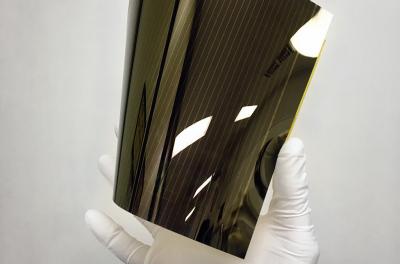Solliance announced a new record stabilized average cell performance of 14.5% for its large thin-film perovskite photovoltaic modules on glass. The efficiency was measured on an aperture area of 144 cm2.

The perovskite module was realized on a commercial 6x6 inch2 glass substrate, a size comparable to standard commercial silicon solar cells. The substrate is provided with a transparent conductor, by applying three consecutive slot die coating processes and using a newly developed annealing process. The metal top electrode was evaporated. Twenty-four cells were series-connected through optimized laser-based scribes. Up to 95.3% of the modules area is covered with active material, resulting in a stabilized module efficiency of 13.8%.
These results further demonstrate the scalability of this new thin film PV technology. Apart from the electrodes currently used, all layers can be processed in ambient environment and at temperatures below 120â°C, making expensive equipment obsolete. The deposition and interconnection technologies are industrially available for both Sheet-to-Sheet and Roll-to-Roll manufacturing. The latter allows creating high volume production of flexible and light-weight PV modules in the future.
'With our newly developed, industry compatible, large area coating and crystallization processes, we were able to scale-up the active area of our solar cell devices with 3 orders of magnitude without any performance loss', explained Francesco Di Giacomo, senior scientist at Solliance Solar Research. 'At the same time, we are in the process of introducing a much more stable material stack into our large area deposition processes'.
'The challenge is to scale perovskite cells to larger size modules whilst keeping the efficiency high and the costs low at a high yield. The reported result, presented on an aperture area comparable to standard commercial silicon solar cells, shows that Solliance Solar Research, with its in depth know-how on processing of organic PV, CIGS and its vast pilot production infrastructure, is excellently placed to realize this upscaling. This 13.8% efficient perovskite based PV module is another important step in this development. Apart from the fact that we are confident to boost quickly the up-scaled Perovskite based PV module efficiency further above 15% we are also currently making good progress to stabilize the performance of these devices under real life operational conditions', explains Ronn Andriessen, Director at Solliance Solar Research.



